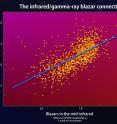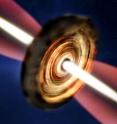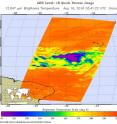Popular Science articles about Astronomy & Space
Explaining why the universe can be transparent
 Two papers published by an assistant professor at the University of California, Riverside and several collaborators explain why the universe has enough energy to become transparent.
Two papers published by an assistant professor at the University of California, Riverside and several collaborators explain why the universe has enough energy to become transparent.
NASA sees Tropical Depression Rai over Thailand, Vietnam, Laos
 After Tropical Depression 19W moved ashore in central Vietnam
NASA-NOAA's Suomi NPP satellite passed over the system and found
some powerful thunderstorms over Thailand, Vietnam and Laos capable
of dropping...
After Tropical Depression 19W moved ashore in central Vietnam
NASA-NOAA's Suomi NPP satellite passed over the system and found
some powerful thunderstorms over Thailand, Vietnam and Laos capable
of dropping...
Reconciling dwarf galaxies with dark matter
 Dwarf galaxies are enigmas wrapped in riddles. Although they are
the smallest galaxies, they represent some of the biggest mysteries
about our universe. While many dwarf galaxies surround our own...
Dwarf galaxies are enigmas wrapped in riddles. Although they are
the smallest galaxies, they represent some of the biggest mysteries
about our universe. While many dwarf galaxies surround our own...
NASA sees 2 landfalls for Hurricane Newton in Mexico
 NASA's Terra and Aqua satellites caught Hurricane Newton's two landfalls in Mexico.
NASA's Terra and Aqua satellites caught Hurricane Newton's two landfalls in Mexico.
NASA sees Hermine's twin towers
 In order for Hermine or any other tropical depression, to intensify
there must be a pathway for heat energy from the ocean surface to
enter the atmosphere. For Hermine,...
In order for Hermine or any other tropical depression, to intensify
there must be a pathway for heat energy from the ocean surface to
enter the atmosphere. For Hermine,...
Images from Sun's edge reveal origins of solar wind
 Ever since the 1950s discovery of the solar wind - the constant
flow of charged particles from the sun - there's been a stark
disconnect between this outpouring and the...
Ever since the 1950s discovery of the solar wind - the constant
flow of charged particles from the sun - there's been a stark
disconnect between this outpouring and the...
Discovery one-ups Tatooine, finds twin stars hosting three giant exoplanets
 A team of Carnegie scientists has discovered three giant planets in
a binary star system composed of stellar ''twins'' that are also
effectively siblings of our Sun. One star hosts...
A team of Carnegie scientists has discovered three giant planets in
a binary star system composed of stellar ''twins'' that are also
effectively siblings of our Sun. One star hosts...
Milky Way had a blowout bash 6 million years ago
 The center of the Milky Way galaxy is currently a quiet place where
a supermassive black hole slumbers, only occasionally slurping
small sips of hydrogen gas. But it wasn't always...
The center of the Milky Way galaxy is currently a quiet place where
a supermassive black hole slumbers, only occasionally slurping
small sips of hydrogen gas. But it wasn't always...
Planet found in habitable zone around nearest star
 Astronomers using ESO telescopes and other facilities have found
clear evidence of a planet orbiting the closest star to Earth,
Proxima Centauri. The long-sought world, designated Proxima b,
orbits its...
Astronomers using ESO telescopes and other facilities have found
clear evidence of a planet orbiting the closest star to Earth,
Proxima Centauri. The long-sought world, designated Proxima b,
orbits its...
Can 1 cosmic enigma help solve another?
Astrophysicists from the Johns Hopkins University have proposed a clever new way of shedding light on the mystery of dark matter, believed to make up most of the universe.
NASA's Aqua satellite sees Super Typhoon Meranti approaching Taiwan, Philippines
 NASA's Aqua satellite provided a visible image of Super Typhoon Meranti as it continued to move toward Taiwan and the northern Philippines.
NASA's Aqua satellite provided a visible image of Super Typhoon Meranti as it continued to move toward Taiwan and the northern Philippines.
NASA's THEMIS sees Auroras move to the rhythm of Earth's magnetic field
 The majestic auroras have captivated humans for thousands of years,
but their nature -- the fact that the lights are electromagnetic
and respond to solar activity -- was only realized...
The majestic auroras have captivated humans for thousands of years,
but their nature -- the fact that the lights are electromagnetic
and respond to solar activity -- was only realized...
Discovery nearly doubles known quasars from the ancient universe
 Quasars are supermassive black holes that sit at the center of
enormous galaxies, accreting matter. They shine so brightly that
they are often referred to as beacons and are among...
Quasars are supermassive black holes that sit at the center of
enormous galaxies, accreting matter. They shine so brightly that
they are often referred to as beacons and are among...
Astronomers discover rare fossil relic of early Milky Way
 Terzan 5, 19 000 light-years from Earth in the constellation of
Sagittarius (the Archer) and in the direction of the galactic
centre, has been classified as a globular cluster for...
Terzan 5, 19 000 light-years from Earth in the constellation of
Sagittarius (the Archer) and in the direction of the galactic
centre, has been classified as a globular cluster for...
NASA science flights study effect of summer melt on Greenland ice sheet
 Operation IceBridge, NASA's airborne survey of polar ice, is flying
in Greenland for the second time this year, to observe the impact
of the summer melt season on the ice...
Operation IceBridge, NASA's airborne survey of polar ice, is flying
in Greenland for the second time this year, to observe the impact
of the summer melt season on the ice...
The supernova that wasn't: A tale of 3 cosmic eruptions
 1800s, astronomers surveying the night sky in the Southern
Hemisphere noticed something strange: Over the course of a few
years, a previously inconspicuous star named Eta Carinae grew
brighter and...
1800s, astronomers surveying the night sky in the Southern
Hemisphere noticed something strange: Over the course of a few
years, a previously inconspicuous star named Eta Carinae grew
brighter and...
Ceres: The tiny world where volcanoes erupt ice
 Ahuna Mons is a volcano that rises 13,000 feet high and spreads 11
miles wide at its base. This would be impressive for a volcano on
Earth. But Ahuna Mons...
Ahuna Mons is a volcano that rises 13,000 feet high and spreads 11
miles wide at its base. This would be impressive for a volcano on
Earth. But Ahuna Mons...
Anomalous grooves on Martian moon Phobos explained by impacts
 Some of the mysterious grooves on the surface of Mars' moon Phobos
are the result of debris ejected by impacts eventually falling back
onto the surface to form linear chains...
Some of the mysterious grooves on the surface of Mars' moon Phobos
are the result of debris ejected by impacts eventually falling back
onto the surface to form linear chains...
Planet Nine could spell doom for solar system
 The solar system could be thrown into disaster when the sun dies if the mysterious 'Planet Nine' exists, according to research from the University of Warwick.
The solar system could be thrown into disaster when the sun dies if the mysterious 'Planet Nine' exists, according to research from the University of Warwick.
ALMA finds unexpected trove of gas around larger stars
 Astronomers using the Atacama Large Millimeter/submillimeter Array
(ALMA) surveyed dozens of young stars -- some Sun-like and others
approximately double that size -- and discovered that the larger
variety have...
Astronomers using the Atacama Large Millimeter/submillimeter Array
(ALMA) surveyed dozens of young stars -- some Sun-like and others
approximately double that size -- and discovered that the larger
variety have...
Cosmic neighbors inhibit star formation, even in the early-universe
 The international University of California, Riverside-led SpARCS
collaboration has discovered four of the most distant clusters of
galaxies ever found, as they appeared when the universe was only 4...
The international University of California, Riverside-led SpARCS
collaboration has discovered four of the most distant clusters of
galaxies ever found, as they appeared when the universe was only 4...
More news about Astronomy & Space
Space News in Images
Breaking science news from the newsfeed about Astronomy & Space
- Old Stardust in Young Galaxy Sheds Light on the First Stars
- Emma Watson's 'The Circle' to debut at the Tribeca Film Festival
- Blue Origin shares video of New Glenn rocket
- New York Giants land WR Brandon Marshall in 2-year, $12 million deal
- San Francisco 49ers signing Brian Hoyer
- Mechanism underlying size-sorting of rubble on asteroid Itokawa revealed
- Watch the Moon Play 'Peekaboo' with Bright Star Aldebaran (Photos, Video)
- Making Astronomy Accessible to the Blind
- Study: Potatoes can grow on Mars
- New survey finds 'Peter Pan' radio galaxies that may never grow up
- Cassini Reveals Changing Conditions at Saturn's Massive Polar Vortices
- Zap Map: Satellite tracks lightning for better heads up
- Risks on Mars Mean Humans Might Want to Follow Opportunity Rover's Tracks
- FLIR delivering CBRN equipment sets
- Saturn's Moon Daphnis Kicks Up Wild Ring Waves (Photo)
- Study: Position and angles of meteor showers constantly shifts
- Extraterrestrial life forms could be 'our neighbours someday': NASA researcher
- 'I Hope They Take a Camera': Astronaut Jim Lovell Talks SpaceX Moon Mission
- Kevin McGahern to host 'Weird America' on Travel Channel
- Watch live: Spicer gives briefing; Dubke named communications director
- North Korean missiles launched into Sea of Japan
- CIA could listen through cellphones, smart TVs, WikiLeaks claims
- A light rain can spread soil bacteria far and wide, study finds
- 'Prison Break,' 'Dirty Dancing' stars booked for PaleyLive talks
- Sentinel-2B poised for liftoff
- Craters show Earth is bombarded at random
- Private Cygnus Spacecraft to Launch NASA Cargo to Space Station Soon
- Trajectories to victory
- We're on the Verge of a Gravitational Wave Astronomy Boom
- S Kendrick Lewis, CB Shareece Wright won't be back with Baltimore Ravens








